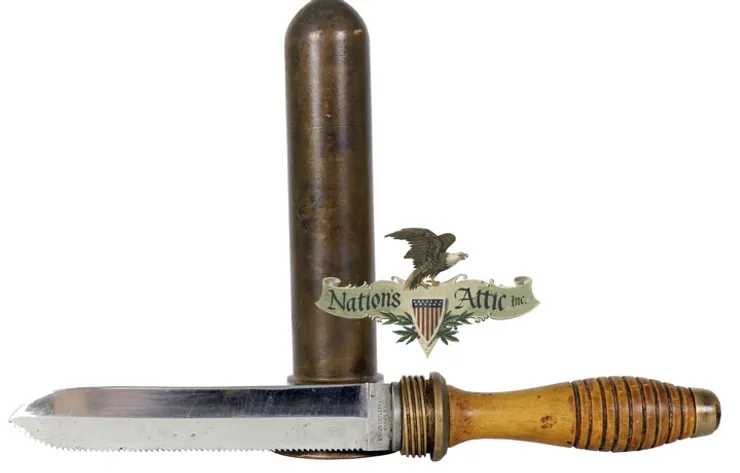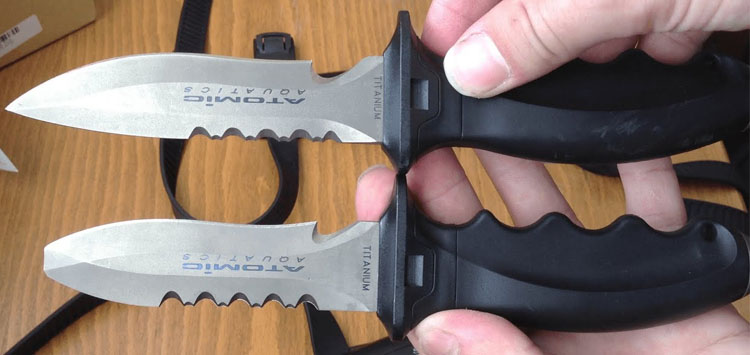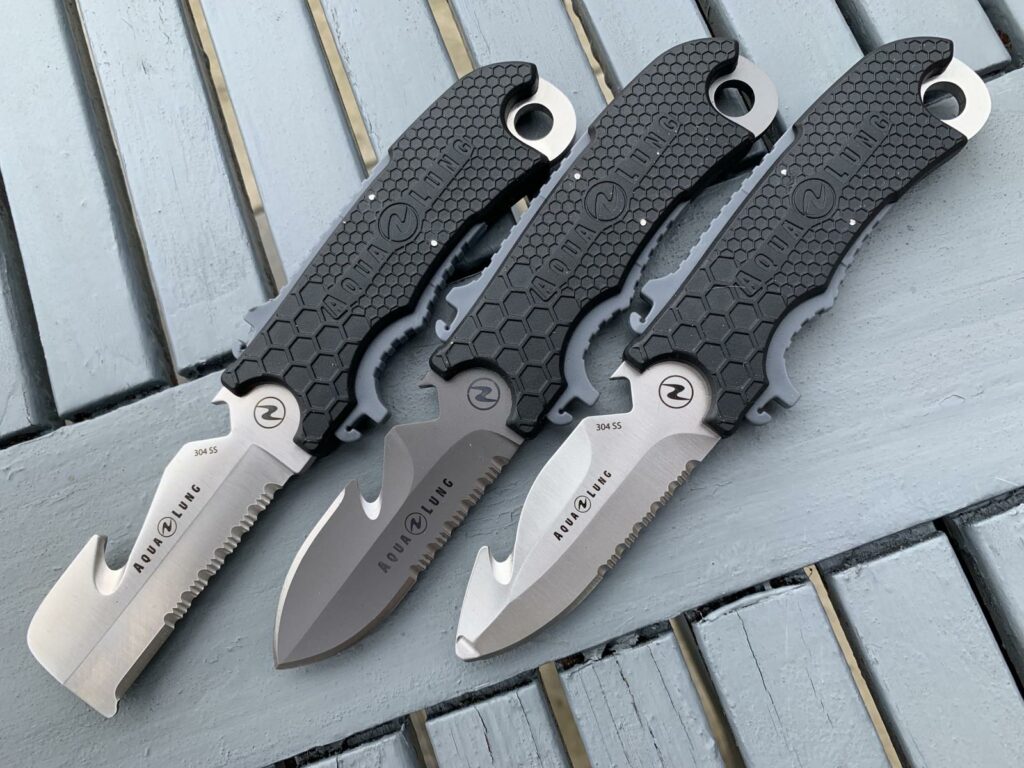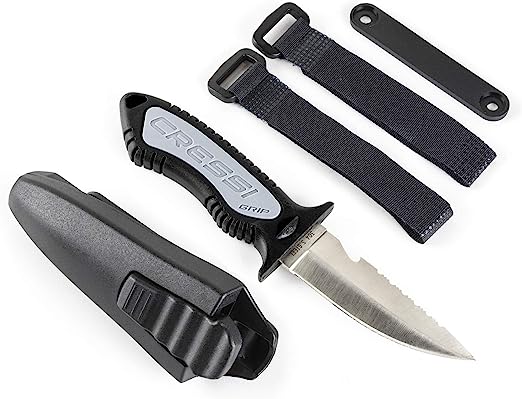Last updated on January 7th, 2024 at 01:34 am
Dive knives are crucial and flexible diving gear. What is a dive knife and why is it necessary for divers? This article covers all you need to know about dive knives.
We’ll cover everything from their function to maintenance and recommended practises. Dive knives are fascinating, so put on your scuba gear and investigate!
What is a Dive Knife?
Divers and snorkelers use diving knives. Divers need it for many reasons. Dive knives include strong, corrosion-resistant blades and wet-grip handles. Divers can accomplish numerous things underwater using their serrated edges and pointy tips.
The History of Dive Knives
Dive knives originated when divers needed a versatile cutting instrument. Dive knives were originally used in emergencies to cut through ropes or cords. As diving equipment and methods improved, dive knives became useful for collecting samples, opening shells, and self-defense.
Types of Dive Knives

Different diving needs require different dive knives. Common dive knives include:
Fixed Blade Dive Knives: Fixed-blade dive knives have a solid, non-folding blade. Their strength and longevity make them excellent for heavy-duty applications.
Foldable Dive Knives: Also called pocket knives, foldable dive knives have a hinged blade that folds into the handle for safe and compact storage. Divers like their versatility and convenience.
Blunt-tipped dive knives: These knives have rounded tips instead of sharp ones. For safety, blunt-tip knives are advised.
Line Cutting Dive Knives: These knives are meant to cut through entangled lines, ropes and fishing nets. They cut quickly with serrated edges.
Choosing the Right Dive Knife

To pick the proper dive knife for your dives, consider various things. Key considerations:
Blade Material: Choose corrosion-resistant stainless steel or titanium blades. These materials can survive underwater.
Blade Length: Dive needs determine blade length. Pry and dig with longer blades, manoeuvre with shorter ones.
Handle Design: Choose a dive knife with a comfortable, ergonomic handle. In damp circumstances, textured handles or rubber grips improve control.
Attachment Options: Check if the knife has sheaths, belts or clips. These features let you attach the knife to your gear or body for quick access.
Essential Features of a Dive Knife

Dive knives should be reliable and functional underwater. Key features include:
Serrated Edge: Serrated edges cut rope, fishing line and kelp efficiently. It improves grip and avoids blade slippage.
Line Cutter: Many dive knives have line cutters in the blade or handle. This instrument cuts through tangled lines rapidly.
Tank Banging point: Some dive knives include a blunt point for pounding tanks to attract other divers. This capability helps in emergencies and underwater communication.
One-Handed Opening: A dive knife that opens and closes with one hand is convenient. This feature makes underwater use easy.
How to Properly Maintain a Dive Knife

Dive knives need regular maintenance to last. Follow these knife maintenance tips:
Rinse After Use: After each dive, clean your dive knife in fresh water to remove seawater and debris. Check the grip, blade, and sheath.
Dry Thoroughly: Air-dry the knife before storing it. Remove moisture to prevent corrosion or rust.
Lubricate: Apply a thin layer of silicone oil or lubricant to the blade and moving parts periodically. This prevents corrosion and improves operation.
Store Properly: Properly store your dive knife in a cool, dry, out-of-the-sun spot. Protect the blade with the sheath.
Best Practices for Using a Dive Knife

These tips will maximise your dive knife:
Safety First: Use the knife safely. Take precautions.
Practice Proper Technique: Practise proper diving knife handling and use. Keep your hold and control.
Be Aware of Marine Life: You’re a guest underwater. Only use the knife to hurt marine creatures if necessary.
Communicate clearly: If you need to use your knife to catch another diver’s attention, tap your tank gently or use other non-threatening signals. Communicating underwater is crucial.
Dive Knife Safety Tips

Fasten Sheath Attachment: Always fasten a dive knife to your gear or body using the sheath, straps, or clips. This prevents misplacement or entanglement.
Avoid Aggressive Use: Dive knives can be used for many activities, but avoid undue force. Avoid injury and equipment damage with delicate pressure and controlled motions.
Inspect Regularly: Keep your dive knife visible and accessible. It should be easy to grab in an emergency.
Inspect Regularly: Regularly check your dive knife for loose or corroded parts. Before diving, fix or replace any knife faults.
Follow Regulations: Check local dive knife laws. Some locations have maritime environment protection rules.
Popular Dive Knife Brands

Several well-known brands make dive knives. Consider these popular ones:
Aqua Lung: Aqua Lung dive knives are durable and practical. Their ergonomically designed knives have stainless steel blades.
Spyderco: Spyderco is known for its innovative folding dive knives. They use serrated blades, line cutters, and corrosion-resistant materials.
Cressi: Cressi makes recreational and professional dive knives. Their knives are sharp, durable, and ergonomic.
Mares: Mares makes dive knives for different diving methods. They make high-quality, user-friendly knives.
Atomic Aquatics: Atomic Aquatics makes high-performance dive knives from corrosion-resistant titanium. Their knives have cutting-edge designs and technology.
The Future of Dive Knives
Dive knives have intriguing prospects as technology advances. Possible developments:
Advanced Materials: Carbon fibre and ceramic composites may make dive knives lighter, stronger, and better.
Integrated Tools: Dive knives may have LED lights, compasses, or underwater communication systems.
Smart Technology: GPS tracking, depth sensors, and real-time data display could improve dive knives.
Improved Safety Mechanisms: Future dive knives may have automatic retraction or lockout features to prevent inadvertent discharges.
Questions (FAQs)
Dive knife materials?
Dive knives are usually stainless steel or titanium. These materials are chosen for their longevity and resistance to underwater conditions.
Dive knives: self-defense?
Dive knives are tools but can be used for self-defense in emergencies. However, preventive, training, and conflict avoidance are crucial.
Dive knife storage: how?
Keep your dive knife cool, dry, and out of direct sunlight to prolong its life. Protect the blade with the sheath.
Dive knives on planes?
Dive knives are usually banned from carry-on luggage for security reasons. They can go in checked luggage. Consult the airline and observe their rules.
Dive knives for spearfishing?
Spearfishing knives are best for spearfishing, but dive knives can be utilised. These blades include spearfishing-specific features.
Dive knife prices: average?
Brand, materials, and features affect dive knife prices. Dive knives cost $30–$200.
Conclusion
Scuba divers and snorkelers need a diving knife for numerous reasons underwater. A well-maintained dive knife can be useful for cutting lines, collecting samples, and self-defense.
Divers can improve their underwater experiences by learning about dive knife kinds, features, and safety. Safety, training, and responsible underwater exploration with your diving knife are key.
